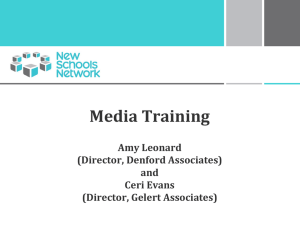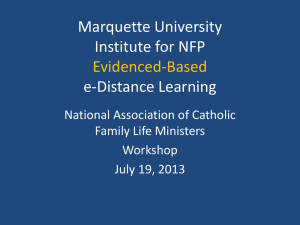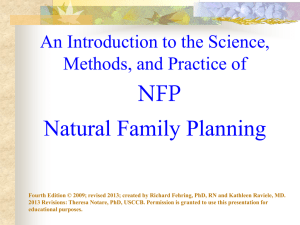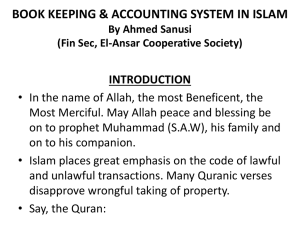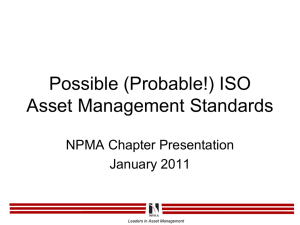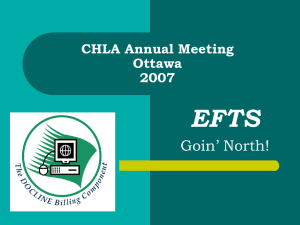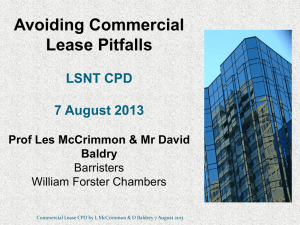the Accounting Audit Presentation
advertisement
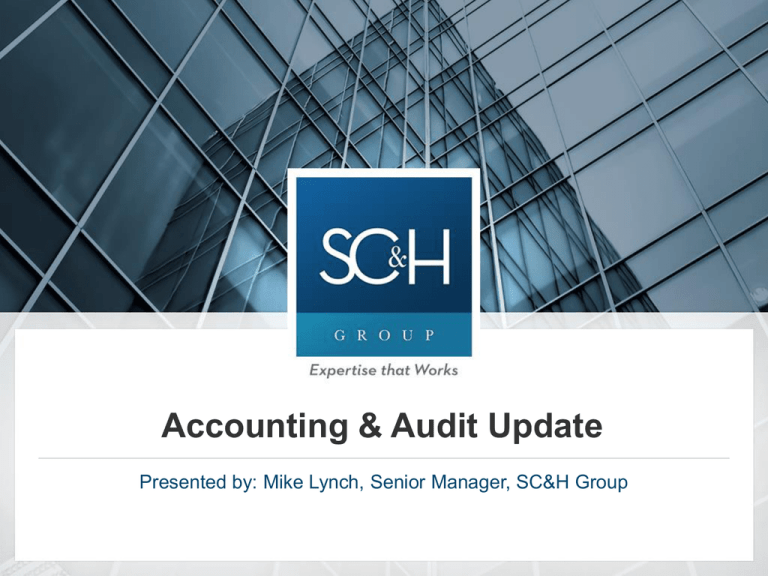
Accounting & Audit Update Presented by: Mike Lynch, Senior Manager, SC&H Group Accounting and Audit Update 2 Agenda Update on Financial Statements of Not-for-Profit Entities Project Proposed lease standard Revenue recognition Other NFP resources and guidance Questions 33 Financial Statements Project Update The purpose of this project is to re-examine the current standards for financial statement presentation for not-forprofit entities with a focus on improving the presentation of net asset classes and providing better information with respect to liquidity, performance and cash flows. Decisions reached to date (mid-March 2014) on the project relate to: presentation and disclosure of liquidity; operating measure; net assets; statements of cash flows; reporting of expenses; and presentation of revenues, expenses, and other changes in net assets. 44 Financial Statements Project Update Presentation and Disclosure of Liquidity ▫ The Board agreed that better information needs to be available to donors, creditors and other users of the financial statements in order to determine the liquidity of not-for-profit entities. This includes information related to the effects of restrictions placed on not-for-profits’ assets and the extent existing obligations impose demands on cash flows. Suggested ways to improve information regarding liquidity are: ▫ Providing a classified statement of financial position (i.e. showing current vs. long term) ▫ Highlighting assets that are limited to their use from other assets either on the face of the financial statements or in the footnotes (i.e. restricted cash) ▫ Disclosing in the notes to the financial statements the nature, timing, amount and effects on liquidity due to external restrictions from donors, creditors, contracts as well as any limits placed by the entity’s board. ▫ Disclosing in the notes specific information related to liquidity such as assets that can be liquidated in the short term to meet demands, polices on the use of liquidity reserves in managing liquidity risks, past liquidity issues and remaining risks and existing conditions and circumstances that are known and are reasonably possible to affect cash flow trends and liquidity. 55 Financial Statements Project Update Operating Measure ▫ The Board has tentatively decided to define an intermediate operating measure on the basis of: • Mission - Whether resources are from or directed at carrying out the not-for-profit’s purpose for existence. • Availability – Whether resources are available for current period activities and reflecting both internal and external restrictions on usage. • Previously this had been defined as a performance indicator akin to income from continuing operations on a for-profit income statement. ▫ The Board is supporting the presentation in which all legally available mission related revenues will be presented before reductions for amounts designated by the governing board for use in future periods, rather than net of these amounts. This presentation will also include resources that had been previously unavailable but were now available in the current period. The presentation will be required for all not-for-profit entities except for business oriented healthcare providers that currently are required to provide a comparable performance indicator. ▫ The Board has tentatively decided that not-for-profits that are reporting the intermediate measure will not be required to report that measure in a statement that also reports the change in unrestricted net assets for the period. 66 Financial Statements Project Update Net Assets (Tentative Board Decisions) ▫ Replace the requirement of presenting totals for the three classes of net assets on the statement of financial position and the changes in those classes on the statement of activities to a requirement that the totals and changes in only two classes of net assets be presented: donor-imposed restrictions and without donor-imposed restrictions. ▫ Retain the current stipulation that information about the nature and amounts of different types of donor-imposed restrictions be provided, but modified the requirement to remove the distinction between temporarily restricted net assets and permanently restricted net assets. Rather, the focus will be on describing the differences based on when and how the resources can be used (i.e. next year vs. never) ▫ Board designated funds will be disclosed as to amount and purpose of the designation within net assets without donor-imposed restrictions. 77 Financial Statements Project Update Statement of Cash Flows ▫ The Board tentatively decided to improve the use of the statement of cash flows by requiring the direct method format for reporting cash used/provided by operating activities and removing the requirement to reconcile the change in net assets to net cash flows from operating activities. Reporting of Expenses ▫ The Board tentatively decided to require NFPs to report expenses by their nature and retain the requirement to report expenses by their function. All NFPs will be required to provide an analysis of all expenses by function and nature in one location – the statement of activities, separate statement of expenses or a schedule in the footnotes. This analysis is to include all expenses, both operating and non-operating. ▫ The Board tentatively decided to require NFPs to include a net presentation of investment expenses against investment returns on the statement of activities, with the types and amounts of investment expenses disclosed in the notes. 88 Financial Statements Project Update As noted previously, the Board has only reached tentative decisions. The project is continuing to receive feedback regarding the Board’s tentative decisions and is seeking input related to the following upcoming topics: • Continuing its research on ways to improve information about liquidity. • Improving not-for-profit specific disclosures. An expected Exposure Draft is to be issued during the second half of 2014. 99 Update on Leases Objective is to increase the transparency and comparability among organizations that lease assets. Recognition, measurement, and presentation of expenses and cash flows arising from the lease by a lessee would depend on whether the lessee is expected to consume more than an insignificant portion of the economic benefits included in the underlying asset (this would depend on the nature of the underlying asset). Lessee - Type A lease (most leases of assets other than property – i.e. equipment, aircraft, cars, trucks) • Recognize a right-of-use asset and a lease liability, initially measured at the present value of the lease payments. • Recognize the unwinding of the discount on the lease liability as interest separately from the amortization of the right-to-use asset. 10 10 Update on Leases Lessee - Type B lease (most leases of property i.e. land and/or building or part of a building): ▫ Recognize the right-of-use asset and a lease liability, initially measured at the present value of lease payments. ▫ Recognize a single lease cost, combining the unwinding of the discount on the lease liability with the amortization of the right-of-use asset, on a straight-line basis. Lessor - Type A lease: ▫ Derecognize the underlying asset and recognize a right to receive lease payments (lease receivable) and a residual asset (representing the rights the lessor retains relating to the underlying asset) ▫ Recognize the unwinding of the discount on both the lease receivable and the residual asset as interest income over the lease term. ▫ Recognize any profit relating to the lease at the commencement date. Lessor – Type B lease: ▫ Continue to recognize the underlying asset ▫ Recognize lease income over the lease term typically on a straight-line basis. 11 11 Update on Leases Status ▫ The FASB and IASB met on January 23, 2014 with the intention of re-deliberating the following topics based on feedback from proposals in the May 2013 exposure draft: • Lessor accounting model • Accounting for “Type A” leases by lessors • Lessee accounting model • Lessee small-ticket leases ▫ The Boards did not arrive at any decisions at this meeting and are expected to meet again to discuss during the second quarter of 2014. 12 12 Revenue Recognition Exchange Transactions vs. Contributions ▫ An exchange transaction is defined as “a reciprocal transfer between two entities that results in one of the entities acquiring assets or services or satisfying liabilities by surrendering other assets or services or incurring other obligations.” ▫ Contributions differ from exchange transactions in that they are defined as “an unconditional transfer of cash or other assets to an entity or a settlement or cancellation of its liabilities in a voluntary nonreciprocal transfer by another entity acting other than as an owner.” 13 13 Revenue Recognition Exchange Transaction Recognition ▫ Examples of exchange transactions for a not-for-profit entity include providing goods or services to members, clients, students, customers or other beneficiaries for a fee. ▫ Revenues from these types of transactions should be recognized when earned based on the accrual basis of accounting and should be measured by the increase in cash, receivables or other assets or the decrease in liabilities resulting from the transaction. • The recognition, measurement and presentation of revenues resulting from exchange transactions are similar for both not-for-profit and for-profit entities. ▫ If members receive benefits from their dues over a period of time, revenue from the dues should be recognized over the period of the membership, not when received. • Nonrefundable initiation and life membership fees received as an exchange transaction should be recognized in the period that they are receivable provided future fees are expected to cover the future costs of services to members. If the initiation and life membership fees are expected to cover future services, the revenue should be recognized over the average duration of membership, life expectancy of members or another reasonable time period. 14 Revenue Recognition Exchange Transaction Presentation ▫ Revenues from exchange transactions should be reported as increases in unrestricted net assets on the statement of activities even when there are legal limitations on the revenue based on a contractual obligation. • Example: Dorm fees paid by students to a educational institution that based on a bond stipulation, should be immediately deposited into a sinking fund to relieve the bonds issued to build the dorm are unrestricted revenues; fees/assessments paid by club members for a new swimming pool are also considered exchange transactions, not contributions. • Revenues should be reported gross of any related expenses, however, expenses that relate specifically to the revenue may be reported following the revenues on the statement of activities (i.e. special events revenue less special events expense followed by a subtotal on the statement of activities). • If discounts are regularly provided by the not-for-profit (i.e. financial aid, fee reductions or free services), these should be reported as net with the associated revenues on the statement of activities . 15 15 Revenue Recognition Exchange Transaction Receivables ▫ Receivables arising from exchange transactions should be reported at net realizable value if due within one year. Receivables that are long-term should be considered for their realizability and reported as such (i.e. consideration of impairment of receivables). • An allowance for uncollectible receivables should be deducted from the receivables it relates to and the amount and determination factors disclosed in the footnotes to the financial statements. ▫ NFPs are required to disclose their significant accounting policies for receivables, the credit quality of its financing receivables, and the allowance for credit losses. Examples of financing receivables include student loans issued by colleges and universities, church mortgages held by church development funds, certain program related investments held by foundations and officer and employee notes receivable. • The relative importance of the financing receivable to the purpose of the NFP determines the depth of disclosure in the financial statements. 16 16 Revenue Recognition Contributions and Agency Transactions ▫ Examples of contributions and agency transactions for a not-for-profit entity include receiving contributions of cash, other assets, and services from individuals, for-profit entities, other not-for-profit entities and governments. Other assets can include investments, land, property and equipment, use of facilities, materials and supplies, intangible assets and unconditional promises to give in the future. ▫ Contributions by definition should be voluntary transfers whereas agency transactions are defined as “a type of exchange transaction in which the reporting organization acts as an agent, trustee, or intermediary for another party that may be a donor or donee.” • When NFPs act as agents, trustees or intermediaries in helping donors make contributions to another NFP, they do not record the transfer of assets as a contribution when received and an contribution expense when transferred to the receiving NFP. 17 17 Revenue Recognition Agency Transactions ▫ The representations made to the donor during the request for gift determine whether the transaction is an agency transaction. If the NFP sets a reasonable donor expectation that the contribution will be transferred to a beneficiary specified by the donor, the NFP is an agent; if the NFP has power to decide on how the gift is donated or is financially related to the specified beneficiary, then a contribution should be recognized by the NFP and is not treated as an agency transaction. ▫ An agent should recognize a liability to the specified beneficiary at the same time that it recognizes cash or other assets from the donor. Both the asset received and the liability incurred should be reported at the fair value of the assets received. • If the agent charges a fee for raising contributions, the revenues and expenses should be reported gross on the beneficiary’s statement of activities. 18 18 Revenue Recognition Transactions that are part contributions, part exchange transactions ▫ Transactions that are part contribution and part exchange transaction include an inherent contribution. • An inherent contribution is defined as “a contribution that results if an entity voluntarily transfers assets (or net assets) or performs services for another entity in exchange for either no assets, or for assets of substantially lower value, and unstated rights or privileges of a commensurate value are note involved”. • The Financial Reporting Executive Committee (FinREC) notes that in cases where the transaction is part contribution and part exchange transaction, NFPs should first determine the fair value of the exchange transaction with the residual reported as a contribution. • Example – land valued at $30,000 is sold to a NFP for $10,000 – an inherent contribution of $20,000 is reported. 19 Revenue Recognition Indicators that are useful in determining type of transaction ▫ Indicator – Recipient NFP’s intent in soliciting the asset • Contribution: Recipient NFP asserts that it is soliciting the asset as a contribution • Exchange Transaction: Recipient NFP asserts that it is seeking resources in exchange for benefits. ▫ Indicator – Resource provider’s expressed intent about the purpose of the asset to be provided by recipient NFP • Contribution: Resource provider asserts that it is making a donation to support the NFP’s programs. • Exchange Transaction: Resource provider asserts that it is transferring resources in exchange for specified benefits. 20 20 Revenue Recognition Indicators that are useful in determining type of transaction ▫ Indicator – Method of Delivery • Contribution: The time or place of delivery of the asset to be provided by the recipient NFP to third-party recipients is at the discretion of the NFP. • Exchange Transaction: The method of delivery of the asset to be provided by the recipient NFP to third-party recipients is specified by the resources provider. ▫ Indicator – Method of determining amount of payment • Contribution: The resource provider determines the amount of the payment. • Exchange Transaction: Payment by the resource provider equals the value of the assets to be provided by the recipient NFP, or the assets’ cost plus markup; the total payment is based on the quantity of assets to be provided. 21 21 Revenue Recognition Indicators that are useful in determining type of transaction ▫ Indicator – Penalties assessed if NFP fails to make timely delivery of assets • Contribution: Penalties are limited to the delivery of assets already produced and the return of the unspent amount. (the NFP is not penalized for nonperformance) • Exchange Transaction: Provisions of economic penalties exist beyond the amount of payment. (the NFP is penalized for nonperformance). ▫ Indicator – Delivery of assets to be provided by the recipient NFP • Contribution: Assets are to be delivered to individuals or organizations other than the resource provider. • Exchange Transaction: Assets are to be delivered to the resource provider or to individuals or organizations closely connected to the resource provider. 22 22 Revenue Recognition Voluntary asset transfers ▫ The following types of transactions should be reviewed closely as they are more difficult to classify as they may be a contribution, an exchange transaction or a combination: • Membership dues • Grants, awards, and sponsorships • Naming opportunities • Gifts in kind 23 23 Revenue Recognition Conditional Promises to Give ▫ When a donor has made the donation conditional based on certain requirements being met, the donation is not recorded until the conditions are met, whether it be all at once or in increments. • Example – a donor has promised to give $1 for $1, up to $500,000, for contributions received by an NFP during a 2 year period. As contributions are received that meet the donor’s requirement, the conditional promise becomes unconditional and a pledge receivable is recorded for the amount. 24 24 Revenue Recognition Unconditional Promises to Give ▫ When a donor has made an unconditional promise to give, they may impose donor restrictions on the gift, either a time or purpose restriction. At the time of the pledge, the NFP will record a pledge receivable for the entire amount and if the pledge is over a period of time, it will be discounted back to present value at the time of the gift and that will be the amount of revenue recorded by the NFP. • Example: a donor promises to give $500,000 over 5 years. The NFP will record a pledge receivable for $500,000, will calculate the PV of the gift using the treasury rate at the time of the gift (5% for the example) Present value of the $500,000 is $432,950 – this will be recorded as temporarily restricted revenue (as it was restricted based on time). The difference is recorded as a discount on contribution and is netted against the receivable. As the restrictions are met (in this example time), a portion of the discount as well as a portion of the temporarily restricted revenue will be recognized as unrestricted revenue. The hope is at the end of the 5 years, all the money has been received and recognized. 25 25 Other NFP Resources and Guidance Resourceful websites containing recently issued guidance, technical Q&A’s, practice bulletins, webinars, podcasts, and CPE courses: • www.fasb.org • www.aicpa.org • www.ifrs.com • www.gasb.com • www.guidestar.org • www.irs.gov 26 26 Contact Information Mike Lynch 410-785-8034 mlynch@scandh.com Visit: www.scandh.com Phone: (800) 921-8490 Email: sch_group@scandh.com 27


